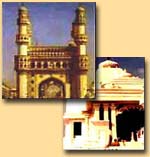|

A Trip to Andhra is, indeed a memorable experience. With an area of 275,068 Sq Km,
the state is geologically one of the most ancient parts of Peninsular India. The
fifth largest state of India, Andhra is rich in historical monuments and natural
beauty. Having a number of holy temples, the state constitutes a great
attraction for pilgrims, besides other visitors. Tirupati, Having presiding
deity Venkateshwara, the temple of Sriramchandra, Bhadrachalam,
Mallikarjunaswami, temple, Srisilam, and srikummam temple are among the most
famous temples of Andhra Pradesh. The capital of Hyderabad is beyond doubt, the
main tourist attractions be it Char Minar or state Museum, Art Gallery or
Salarjung Museum - All of them have expositions connected with history, art and
culture, especially of the Nizam Period. Once noted for its mines of diamond,
Golconda has some famous historical monuments. Alas! the place from where the
Kohinoor and Pitt diamonds came, does not have these precious pieces to put an
exhibit. The Nagarjuns Sagar dam is also a popular tourist spot. So are the
Yadagir Gutta, Nalgonda, Thousand Pillar temple, Warangal and Vemulwada,
Karinagar. Last but not the least, the largest tiger reserve in India. Nagarjuna
Srisailam Sanctuary, is the perfect travelmasti for wildlife freaks. Andhra Pradesh is situated on
the Deccan plateau - one of the oldest geological formations in India.
With its recent foray into information technology, through the new hi-tech
centre on the outskirts of Hyderabad. The capital Hyderabad-Secunderabad
is naturally a magnet due to its Muslim heritage. Nagarjunakonda provides
evidence of early Hindu-Buddhist societies and in the south , Tirumala and
Puttaparthi are two of the most visited pilgrimage sites in the world. The State
of Andhra Pradesh which covers a large part of the Deccan, extends over an
area of nearly 3 lakh sq.km. and has a population of more than 6 crores.
Bounded by Orissa and Madhya Pradesh on the North, Bay of Bengal in the
East, Tamil Nadu on the South and Karnataka and Maharastra on the West,
Andhra Pradesh is the fifth largest State in the Indian Union. It has a
long sea-coast extending nearly 1000 km. The State today with 23 Districts
has three distinct geographical regions – Rayalseema, Coastal and
Telangana. Known familiarly as Annapurna for its bounty, Andhra Pradesh
has been the rice-bowl of the country with its most fertile Krishna and
Godavari delta. Andhra Pradesh, in addition to its natural beauty has a
very chequered and hoary past.
The State is surrounded by
Madhya Pradesh and Orissa in the north, the Bay of Bengal in the east,
Tamilnadu and Karnataka in the south and Maharashtra in the west. Andhra
Pradesh forms the major link between the north and the south. The northern
area of Andhra Pradesh is mountainous with an annual rain-fall of 110 to
125 cm. The highest peak Mahendragiri rises 1500 m. (4,920 ft.)
above the sea level. The climate is generally hot and humid. The State is
principally fed by the southwest monsoon. The northeast monsoon
contributes about one-third of the rainfall.
The Satavahana
dynasty ( 2nd century B.C.- 2nd century A.D), also known as the Andras,
took control of much of central and southern India. They had their
capital at Amaravati on the Krishna. They enjoyed extensive
international trade with both eastern Asia and Europe. The
Satavahanas too were great patrons of Buddhism. Subsequently, the Pallavas
from Tamil Nadu, the Chalukyas from Karnataka, and the Cholas
all held sway. In the 13th century, the Kakatiyas, with
their capital at Warrangal, dominated Andhra Desa. They were
under the constant threat from Muslim incursions, while later on, after
the fall of their city at Hampi, the Hindu Vijayanagars transferred
operations to Chandragiri near Tirupati.
Top
|
|



